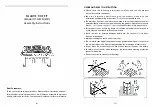
58
Maintenance
20.14 Troubleshooting
Please check to make sure the instructions are followed exactly before attempting troubleshooting of the appliance.
WARNING:
Troubleshooting and servicing of gas and electrical devices of the appliance should only be conducted by a qualified ser-
vice technician.
SYMPTOM
ACTION
Pilot will not light after pressing
the sparker many times.
1.
When lighting the appliance for the first time after installation or after servicing, there is air in
the gas line. It takes a while for all of the air to purge out of the pilot before gas can reach the
pilot and ignite. Remove the glass door and press the igniter many times while holding the
pilot knob down to purge the air.
2.
Check to make sure the gas supply to the appliance is turned on and there is adequate gas
supply pressure to the appliance.
3.
Check for sparks between the spark electrode and the pilot head when the sparker is
pressed. If there are no sparks:
a. Check for broken or poor connection from the sparker to the electrode.
b. Check for the spark shorting or arcing at other locations.
c. Check for defective sparker.
d. Check for defective spark electrode.
4.
With the door removed, try lighting the pilot with a match.
a. If air is blowing on the flame of the match, hold the control knob in at the ‘PILOT’ setting
until all the air is purged out of the line.
b. If there is no gas or air coming out of the pilot and there is gas pressure to the appliance,
the pilot orifice may be blocked or the gas valve may be defective.
Pilot will not remain on after being
lit.
1.
Press the control knob all the way in (at the “pilot” indicator).
2.
Hold the control knob in for a longer period of time.
3.
If you are trying to re-light the pilot immediately after you have shut-off the pilot, you have to
wait 60 seconds for the valve to reset (safety system built into the valve).
4.
Check for poor connection of the thermocouple to the valve.
5.
Check for proper voltage of the thermocouple. The thermocouple should generate at least 20
mV or it is defective.
6.
Check for defective gas valve.
The main burner does not turn on
with the pilot lit.
1.
Check to make sure the control knob is turned to the ‘
ON
’ position.
2.
Allow enough time for the pilot to heat up the thermopile to generate sufficient voltage to
activate the valve.
3.
Check to make sure the wall switch is on thermostat (if installed) is set high enough to turn
on the appliance.
4.
Check that the remote switch or the thermostat is turned on.
5.
Check to see if the pilot flame is large enough to reach and surround the thermopile. If the
flame is too small, check for correct gas supply pressure. If pressure is good, adjust the pilot
flame size with the adjustment screw on the valve. If the flame cannot be adjusted, there
might be some debris obstructing the pilot orifice, or an incorrect size pilot orifice setting.
6.
Check all connections to the valve for tight electrical contact.
7.
Check for 400-500 mV from the thermopile with the burner off and 185-250 mV with the
burner on. If the voltages are lower, the thermopile is defective.
8.
Check for defective gas valve.
The main burner shuts off when
the appliance is warm.
1.
This may be the normal operation of a wall thermostat installed to appliances.
2.
Check for good pilot flames on the thermopile.
3.
Check for good voltage from the thermopile.
4.
If venting is suspected, refer to the venting section of this manual for proper venting
practices.
5.
Check wire connections. Expansion from heat affects a loose connection.
Sooty deposits on the glass door.
1.
If the flame is yellow and lazy, check for lint etc. around primary air shutter. Increase primary
air by opening the primary air shutter if necessary.
2.
Check for proper placement of the logs and branches. Ensure logs and burner are clean.
See that section in the instruction manual.
3.
Check for proper venting and blockage of the vent termination.
4.
Check manifold pressure and clock input rating for over-firing.
Содержание 22-DVIE22LN-1
Страница 64: ......







































